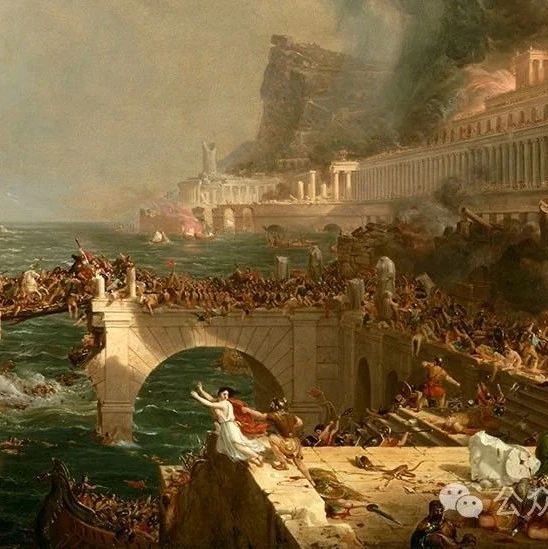Links Between East and West 60 Societal Collapse 东西方的连接60 - 文明衰落
History illustrates that civilizations seemingly come to an end inevitably. As the British philosopher Henry St. John, First Viscount Bolingbroke, wrote in 1738, “The best instituted governments carry in them the seeds of their destruction: and, though they grow and improve for a time, they will soon tend visibly to their dissolution. Every hour they live is an hour the less that they have to live.” This quote begs the question: Why are civilizations doomed to collapse? This essay defines the term “collapse” under a civilizational context as a state when civilization stops functioning, succumbing to political disintegration, economic decline, and drastic demographical change.
Scholars today attribute the downfall of civilizations to a variety of factors. Some anthropologists, such as Jared Diamond, the author of Collapse: How Societies Choose to Fail or Succeed, argue that the cause of civilizational collapse is the mismanagement of natural resources. Others say that uncontrollable environmental factors like climate disasters doomed many historical civilizations. This essayist believes that these arguments only touch on the apparent reasons. This essay will argue that there are two ultimate reasons for the failure of civilizations: Human civilizations fail because they are inherently complex, flawed systems, and they tend to display societal cognitive decline and diminishing returns of effectiveness to solve critical issues.
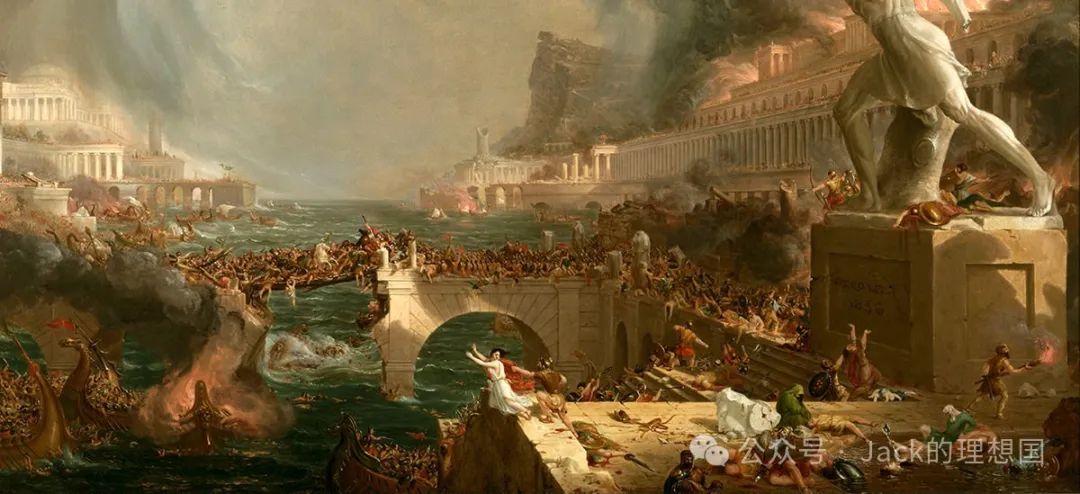
(The Goths sack Rome, 410 C.E.)
First, civilizations are structurally flawed and fragile systems of great complexity. Thus, like an intricate natural ecosystem, a relatively minor shock can cause unanticipated and fatal blows. The idea of “complexity” refers to civilization’s heterogeneity – composed of many distinct, intertwined parts. Political and economic systems, even in the early Mesopotamian and Egyptian eras, consist of multiple levels of organization and are characterized by the interactions of dispersed parties. This inherent complexity makes a government less flexible and competent when responding to emergencies and unexpected events. For example, the Western Roman Empire, a notable civilization in late antiquity, collapsed suddenly during the late fifth century when Germanic tribes, such as the Goths, overran its territories. The Roman civilization’s complex bureaucratic system that relied heavily on the competency of its emperor was fraught with administrative corruption at the time. Consequently, the system was highly inefficient, unable to mobilize the necessary military resources to combat the barbaric tribes. The eventual responses were delayed. In this case, due to the complexity and fragility of the empire, a relatively minor event – the invasion of Germanic tribes – had an amplified effect on bringing a functioning Roman civilization down in just several decades.

(Mikhail Gorbachev)
The complicated nature of states might additionally result in their leaders being unable to foresee many impactful ramifications of their policies or decisions. The Soviet Union, under the leadership of Mikhail Gorbachev, dissolved in this way. When Gorbachev took power in 1985, the civilization was still a superpower. According to some estimates, its economy was 60 percent the size of America’s. The Soviets possessed more nuclear warheads than the U.S., and governments in the “Third World,” as the historian Niall Ferguson puts it, “from Vietnam to Nicaragua, had been tilting in the Soviets’ favor.” However, the communist state was incredibly vast and complex, consisting of many smaller constituent republics and political powers. As Gorbachev pushed forth his well-intentioned “Perestroika” and “Glasnost” policies, he could not predict their actual consequences on all impactful parties due to the compounded nature of the Soviet state. He could not realize that the subsequent decentralization of power encouraged independence movements in the constituent republics and shifted de facto control away from Moscow. Nor could he realize that the unpopularity of Perestroika led to domestic political unrest and coups, bringing further destabilizing effects. Eventually, these seemingly insignificant factors generated an immense amplifier effect, toppling the Soviet Union.
Aside from the inherent complexity of civilizations, another ultimate cause of civilizational collapse is the decline of social cognition and the decreasing ability to solve critical issues. The anthropologist Joseph Tainter champions this view with his theory about the “diminishing returns on investments in social complexity,” first formulated in the late 1980s. Tainter claims that when societies solve social challenges, such as a shortage of energy, they invest efforts to develop new layers of bureaucracy, infrastructure, or hierarchy, complicating the social structure. There is a positive relationship between social complexity and its administrative costs, contributing to an eventual societal collapse.
The fall of the Romans may be viewed from this lens. Since the Third Century Crisis, Roman agricultural output plummeted while the population enlarged, consequently causing per-capita energy availability to diminish. The Romans tackled this issue by conquering their neighbors to loot their land, grain, slaves, and other materials of value. This move made Roman civilization more convoluted. As the empire grew, it required an expansive bureaucracy. The costs of maintaining communications and civil government skyrocketed. According to Tainter, “emperors upon accession were often faced with an insolvent government, and rarely were able to accumulate reserves for emergencies.” When new challenges like foreign invasions emerged, the empire had to respond by further investing in social complexity, which it could not achieve as effectively as before due to rising administrative costs. Such a financial crisis ended the flourishing Roman Empire within a century.
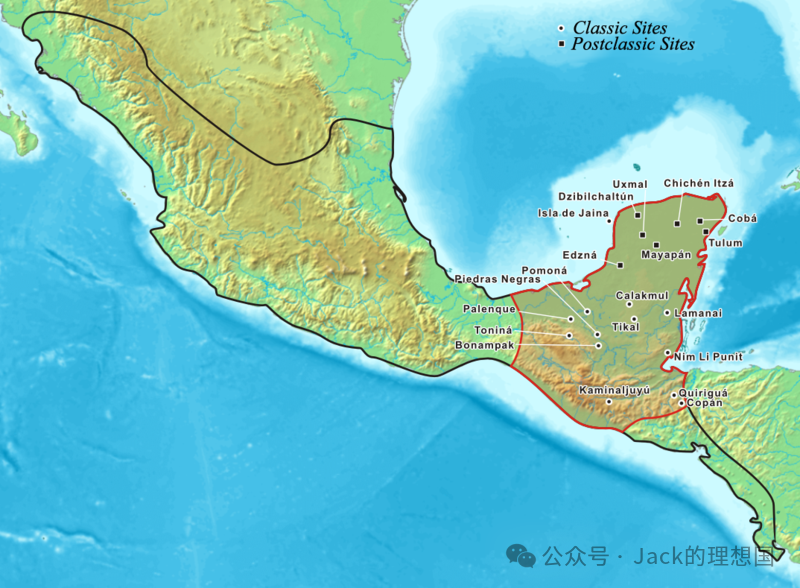
The classic Mayan civilization collapsed similarly. During the Late Preclassic period, from around 400 B.C.E. to 250 C.E., the Mayan population became increasingly dense, creating a greater strain on agricultural productivity, which was less fertile owing to the slash-and-burn technique that the Mayans adopted. Many Mayan tribes found a solution by waging warfare and raiding other tribes. This establishment of competitive relations had long-lasting political implications. As David Webster, an expert on the Mayans, explains, the organization of warfare called for a supreme leadership role that resulted in the emergence of a social hierarchy – a sign of increased social complexity. Maintaining a hierarchy harbored huge implicit economic costs as corruption and economic stratification ravaged. Maintaining the hierarchy weakened the economy’s strength and the society’s flexibility to tackle other challenges like climate change, ultimately dooming the longevity of the Mayan civilization.
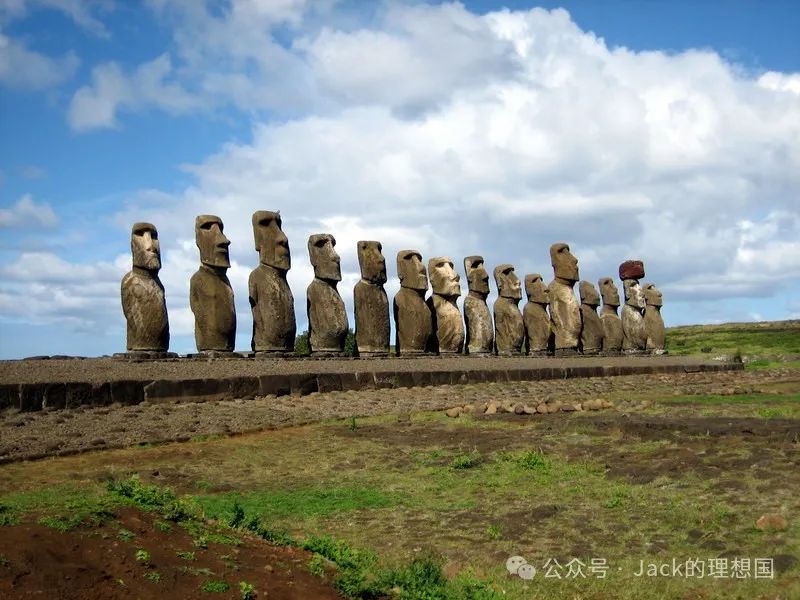
(The moai)
Admittedly, the view that Diamond and some other historians harbor - civilizations collapse because of mismanagement of natural resources – is not without any merit. Especially in civilizations where power was more centralized, a single shortsighted decision made by the rulers could bring resounding ramifications. For example, the Rapanui, who built a civilization on the Easter Islands, cleared the forest for arable land and logs to help move the moai, colossal stone statues, from their quarries. It happened that this decision destined their civilization to collapse. In a 2001 paper, historians Rafael Reuveny and John Maxwell illustrate that the topsoil suffered from severe erosion as the forest disappeared. Moreover, the Rapanui could not venture into rougher waters to fish with no wood for boats. The population declined dramatically over several centuries, and when the Europeans arrived during the late 18th century, the island was nearly barren. The case of the Rapanui civilization does seem to validate the argument that human decisional errors, not societal structural flaws or the decreasing ability to tackle social challenges, were the culprits behind the collapse of civilizations.
However, upon closer examination of the tools of mathematics, the above argument fails to convince. In a comprehensive 2009 journal article written by David Good and Rafael Reuveny, published by the Oxford University Press in the American Journal of Agricultural Economies, the two authors conducted a mathematical modeling and simulation methodology. Their models show that for the collapse of four civilizations, including the Rapanui, the human decision factor was less significant than conceived by many academicians. Even when a ruler had perfect information and impeccable resource management plans that maximized individual utility, these civilizations were still doomed to disintegrate. While this paper’s content is limited in that it does not provide a historical reason for this conclusion, it still suggests that civilization collapse had more to do with the structural designs of societies rather than the cognitive biases of their leaders.
What are the modern implications of the findings above? First, debating about the decline phase that the world is currently in is a waste of effort. Policymakers and citizens alike should be more concerned about a “precipitous and unexpected fall,” in the words of Ferguson, like the one that occurred to the Western Roman Empire, the Soviet Union, and many other civilizations. Second, whether it was the Romans or the Mayans, their civilizations’ downfalls were associated with economic crises, such as a severe imbalance between revenues and expenditures. Alarm bells should thus be ringing urgently today. The U.S. federal debt-to-GDP ratio is well above 120 percent. China’s export prices, a crucial indicator of deflationary pressure and the global economy’s health, are at their lowest levels in 14 years. Such numbers are bad, but for current civilizations, the role of perception is just as imperative. These numbers can undermine the public’s faith in these powerhouses’ strengths. When one day, a seemingly random piece of grim news makes the headlines, as in the case of the collapse of the Lehman Brothers in 2007, suddenly, an overwhelming shift in public opinion might maim today’s civilizations. The complex systems of the Romans and Soviets crumpled under the blows of a series of relatively minor shocks. Since then, the world has only grown more complicated, making it increasingly brittle and fragile.
Though one cannot underestimate the danger that civilizations are now in, there are reasons to believe that humanity may be capable of avoiding armageddon. Historically, civilizations collapsed due to the diminishing ability to solve constantly arising issues. However, Tainter does simultaneously point out that if there is a significant leap in technology or productive efficiency, then civilizations may gain novel, ever more powerful tools to combat challenges effectively. From the 1980s, when Tainter first published his theories, impressive developments in digital technologies and artificial intelligence (“A.I. ") occurred. A.I. holds unbounded potential to be a positive game changer. The large language models are on track to become the most powerful companions. They can exponentially boost labor productivity and create new jobs in the labor market. A.I. has so much unleashed power to tackle the otherwise thorny challenges in health care, climate change, and education. The world is in an age of technological innovation, potentially “rejuvenating” modern civilization.
Overall, this essayist argued that historical civilizations collapsed due to structural flaws in their complex designs and the effects of diminishing returns of effectiveness to solve critical issues. Civilizations often do not behave in a predictable, periodic pattern of “appear, rise, reign, decline, and fall.” Instead, they act like any other complex adaptive system. They function in equilibrium for a certain period and then may abruptly fall to pieces. Thomas Cole, an American painter and historian, highlights that the “shift from consummation to destruction and then to desolation is not cyclical. It is sudden.”
Such historical analysis indicates that today’s civilization is in an age when grave dangers and unlimited opportunities coexist. The risks lie in the notion that the world can be blind to unforeseen, deadly traps lying ahead. Many civilizations analyzed above survived several destructive wars and yet succumbed to some relatively insignificant incursion or internal unrest. Who knows what might be the harbinger of modern civilization’s fall? A COVID-like pandemic? A climate calamity? A third world war? An economic depression, far more repercussive than the 1929 or 2008 disasters? Or a combination of unfortunate events that led to a cascade of catastrophes? In such an unpredictable era, world leaders must emphasize unity and innovation over anything, for these values withstood the test of time, sustaining some of the most glorious times in history.
文明的终结似乎是不可避免的。正如英国哲学家,博林布鲁克子爵一世亨利-圣约翰(Henry St. John)在 1738 年写道:"最好的政府都带有毁灭的种子:尽管它们在一段时间内不断发展和完善,但很快就会明显走向解体。它们每多活一小时,就少活一小时"。这句话引出了一个问题: 为什么文明注定要崩溃?本文将文明语境下的"崩溃 "一词定义为文明停止运转,瓦解于政治解体、经济衰退和人口剧变的一种状态。
当今的学者将文明的衰落归因于多种因素。一些人类学家,如《崩溃》一书的作者贾里德-戴蒙德(Jared Diamond),认为文明崩溃的原因在于自然资源管理不善。还有人说,气候灾害等不可控制的环境因素注定了许多历史文明的灭亡。本文作者将论述,这些论点只触及了表面原因。本文将论证文明失败的两个终极原因:人类文明之所以失败,是因为它们本质上是复杂的、有缺陷的系统,而且它们在解决关键问题时往往会表现出社会认知的衰退和效率的递减。
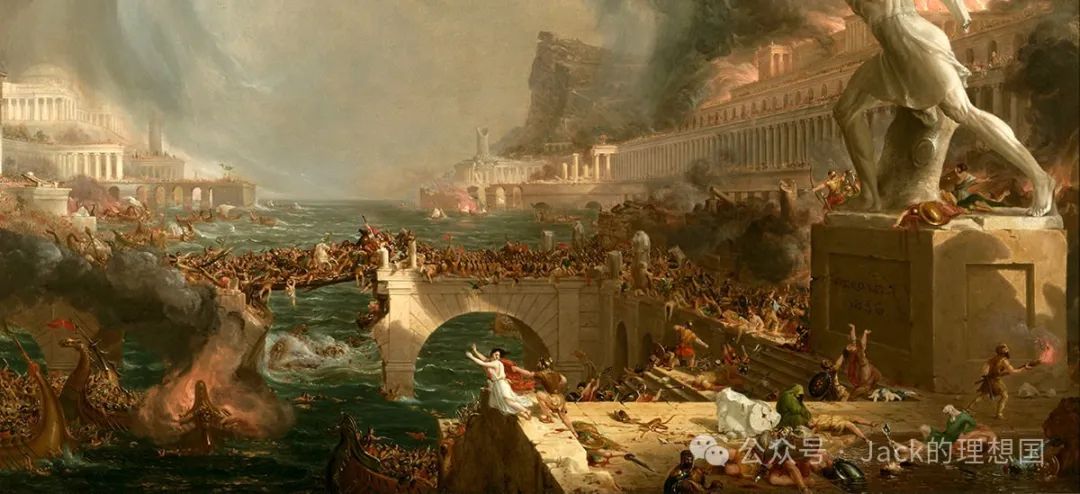
(哥特人410年洗劫罗马)
首先,文明是结构上有缺陷的脆弱系统,具有极大的复杂性。因此,就像错综复杂的自然生态系统一样,一个相对较小的冲击就可能造成意想不到的致命打击。“复杂性 "这一概念指的是文明的异质性--由许多不同的、相互交织的部分组成。即使在早期的美索不达米亚或埃及时代,政治与经济体系也是由多层次的组织构成的,其特点是分散的各方相互作用。这种固有的复杂性使得政府在应对紧急情况与突发事件时缺乏灵活性与能力。例如,西罗马帝国是古代晚期的一个著名文明,但在五世纪末,哥特人等日耳曼部落侵占了它的领土,使其突然崩溃。罗马文明复杂的官僚体系在很大程度上依赖于其皇帝的能力,但在当时却充满了行政腐败。因此,该系统效率极低,无法调动必要的军事资源来打击野蛮部落,最终的应对措施也被拖延。在这种情况下,由于帝国的复杂性与脆弱性,一个相对较小的事件--日耳曼部落的入侵--产生了放大效应,使一个正常运转的罗马文明在短短几十年内衰落。

此外,国家的复杂性还可能导致其领导人无法预见其政策或决策所带来的诸多影响。戈尔巴乔夫领导下的苏联就是这样解体的。戈尔巴乔夫 1985 年掌权时,苏联仍是一个超级大国。据估计,其经济规模是美国的 60%。苏联拥有比美国更多的核弹头,而 "第三世界 "的政府,正如历史学家尼尔-弗格森所说,"从越南到尼加拉瓜,一直在向苏联倾斜"。然而,共产主义国家极其庞大、复杂,由许多较小的加盟共和国及政治势力组成。戈尔巴乔夫在推行他用心良苦的 "改革 "和 "开放 "政策时,由于苏联国家的复合性质,他无法预测这些政策对所有有影响的方面产生的实际后果。他没有意识到,随后的权力下放鼓励了各加盟共和国的独立运动,并将实际控制权从莫斯科转移出去。他也没有意识到,改革不受欢迎导致了国内政治动荡和政变,带来了进一步的不稳定影响。最终,这些看似微不足道的因素产生了巨大的放大器效应,推翻了苏联。
除了文明固有的复杂性之外,文明崩溃的另一个最终原因是社会认知的衰退和解决关键问题能力的下降。人类学家约瑟夫-泰恩特(Joseph Tainter)在 20 世纪 80 年代末首次提出了 "社会复杂性投资回报递减 "理论,并将这一观点奉为圭臬。泰因特声称,当社会解决能源短缺等社会挑战时,他们会投入精力发展新的官僚机构、基础设施或等级制度,从而使社会结构更加复杂。社会复杂性与行政成本之间存在正相关关系,成本无限度的增加最终导致社会崩溃。
罗马人的衰落可以从这个角度来看。自第三世纪危机以来,罗马农业产量急剧下降,而人口却不断增加,从而导致人均能源供应减少。罗马人通过征服邻国,掠夺他们的土地、粮食、奴隶和其他有价值的物资来解决这个问题。此举使罗马文明更加错综复杂。随着帝国的发展,它需要一个庞大的官僚机构,维持通信和文官政府的成本急剧上升。根据泰因特的说法,"皇帝在即位时往往面临政府资不抵债的局面,很少有能力积累储备以备不时之需"。当外敌入侵等新挑战出现时,帝国不得不通过进一步投资于社会复杂性来应对,但由于行政成本的上升,帝国无法像以前那样有效地实现这一点。这种金融危机在一个世纪内终结了繁荣的罗马帝国。
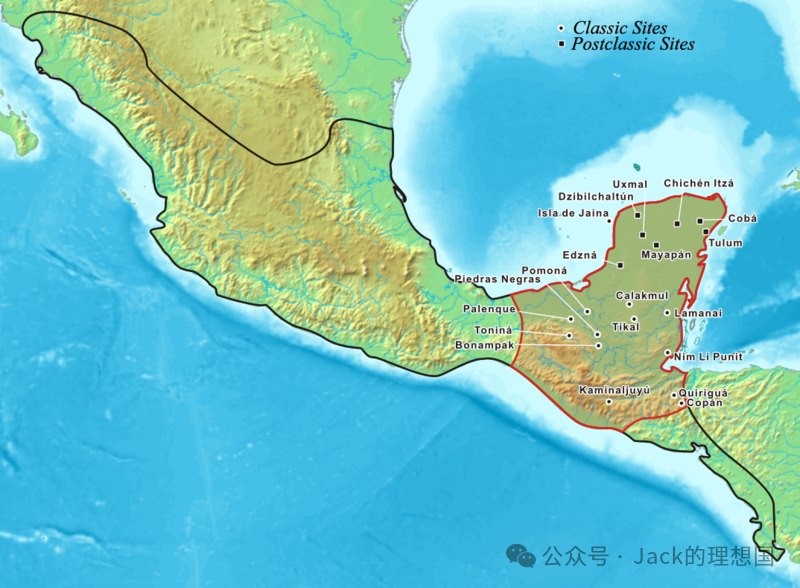
(玛雅文明的地图)
古典玛雅文明也经历了类似的崩溃。在大约公元前 400 年到公元前 250 年的前古典晚期,玛雅人的人口越来越密集,给农业生产造成了更大的压力。许多玛雅部落通过发动战争和袭击其他部落找到了解决办法。这种竞争关系的建立产生了长期的政治影响。正如玛雅专家大卫-韦伯斯特(David Webster)所解释的那样,组织战争需要最高领导者的作用,这导致了社会等级制度的出现--这是社会复杂性增加的标志。由于腐败及经济分层的肆虐,维持等级制度隐含着巨大的经济成本。维持僵化的等级制度削弱了经济实力和社会应对气候变化等其他挑战的灵活性,最终注定了玛雅文明的终结。
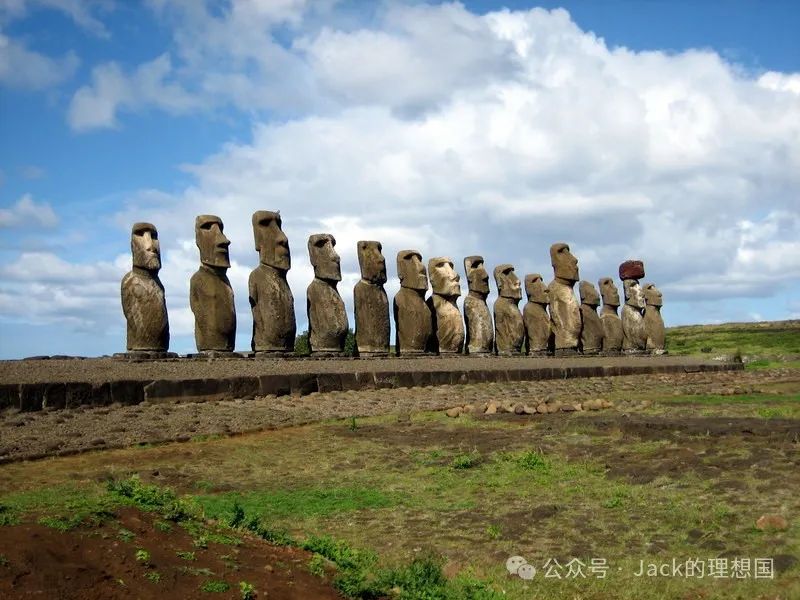
诚然,戴蒙德和其他一些历史学家所持的观点--文明崩溃的原因是自然资源管理不善--并非毫无道理。尤其是在权力比较集中的文明中,统治者一个短视的决定就可能带来巨大的影响。例如,在复活节岛上建立文明的拉帕努伊人(Rapanui)砍伐森林,以获得可耕地和原木,帮助从采石场搬走莫埃(Moai)巨石雕像,这一决定注定了他们文明的崩溃。历史学家拉斐尔-鲁维尼(Rafael Reuveny)与约翰-马克斯韦尔(John Maxwell)在 2001 年的一篇论文中指出,随着森林的消失,表土遭到严重侵蚀。此外,拉帕努伊人在没有木材造船的情况下,无法到波涛汹涌的水域捕鱼。几个世纪以来,岛上人口急剧下降,当欧洲人在 18 世纪晚期抵达时,岛上几乎一片荒芜。拉帕努伊文明的案例似乎验证了这样一个论点:文明崩溃的罪魁祸首是人类的决策失误,而不是社会结构缺陷或应对社会挑战的能力下降。
然而,研究数学模型后,上述论点无法令人信服。2009 年,大卫-古德(David Good)和拉斐尔-鲁维尼(Rafael Reuveny)在牛津大学出版社出版的《美国农业经济杂志》(American Journal of Agricultural Economies)上发表了一篇综合性期刊文章,两位作者采用了数学建模和模拟方法。他们的模型显示,在包括拉帕努伊人在内的四个文明的崩溃中,人类决策因素的重要性低于许多学者的设想。即使统治者拥有完美的信息与无懈可击的资源管理计划,使个人效用最大化,这些文明仍然注定要解体。虽然本文的内容有限,没有为这一结论提供历史原因,但它仍然表明,文明的崩溃更多地与社会的结构设计有关,而不是其领导者的认知偏差。
上述发现的现代意义是什么?首先,争论世界目前所处的衰落阶段是白费力气。用弗格森的话说,政策制定者和公民更应该关注的是 "猝不及防的衰落",就像西罗马帝国、苏联与其他许多文明一样。其次,无论是罗马人还是玛雅人,他们文明的衰落都与经济危机有关,比如收支严重失衡。因此,今天的警钟应该紧急敲响。美国联邦债务与GDP的比率远远超过120%。作为通货紧缩压力和全球经济健康状况的重要指标,中国的出口价格正处于14年来的最低水平。这些数字固然糟糕,但对于当前的文明而言,人们对这些数字产生观念的作用同样至关重要。这些数字会削弱公众对这些强国实力的信心。当有一天,一则看似偶然的噩耗成为头条新闻时,比如 2007 年雷曼兄弟公司的倒闭,突然之间,公众舆论的巨大转变可能会戕害当今的文明。罗马人与苏联人的复杂体系在一系列相对较小的冲击下崩溃了。从那时起,世界只变得越来越复杂了,也因此越来越脆弱了。
虽然我们不能低估文明目前所面临的危险,但我们有理由相信人类有能力避免世界末日。从历史上看,文明的崩溃都是由于解决不断出现的问题的能力越来越弱。不过,泰因特也同时指出,如果技术或生产效率出现重大飞跃,那么文明就可能获得新颖、更加强大的工具,从而有效地应对挑战。从 20 世纪 80 年代泰因特首次发表他的理论开始,数字技术和人工智能("A.I.")取得了令人瞩目的发展。人工智能具有无限的潜力,可以积极地改变游戏规则。大型语言模型有望成为最强大的伙伴,它们可以成倍地提高劳动生产率,为劳动力市场创造新的就业机会。人工智能可以释放出巨大的能量,解决医疗保健、气候变化和教育等领域原本棘手的挑战。世界正处于一个技术创新的时代,有可能 "复兴 "现代文明。
总之,本文作者认为,历史文明的崩溃是由于其复杂设计的结构性缺陷,以及解决关键问题的效力回报递减的影响。文明的行为往往不是 "出现、崛起、统治、衰落、没落 "这种可预测的周期性模式。相反,它们就像其他复杂的适应系统一样,它们在一定时期内处于平衡状态,然后可能短期内崩溃。美国画家、历史学家托马斯-科尔(Thomas Cole)强调,"从圆满到毁灭,再到荒芜的转变不是周期性的 - 它是突然的"。
这种历史分析表明,当今文明正处于一个严重危险与无限机遇并存的时代。危险在于,世界可能会对前方不可预见的致命陷阱视而不见。上文分析过的许多文明都经历过数次毁灭性战争,但还是屈服于一些相对微不足道的入侵或内部动乱。谁知道什么会成为现代文明衰落的先兆?是类似 COVID 的大流行病?是气候灾变?是第三次世界大战?是比 1929 年或 2008 年灾难影响更大的经济萧条?亦或是一系列不幸事件的组合,导致一连串的灾难?在这样一个不可预测的时代,世界领导人必须如此强调“团结“和”创新“,因为这些价值观经受住时间的考验,它们支撑且铸造了人类历史中最稳定、繁荣、辉煌的时代。
- 本文标签: 原创
- 本文链接: http://www.jack-utopia.cn//article/641
- 版权声明: 本文由Jack原创发布,转载请遵循《署名-非商业性使用-相同方式共享 4.0 国际 (CC BY-NC-SA 4.0)》许可协议授权
